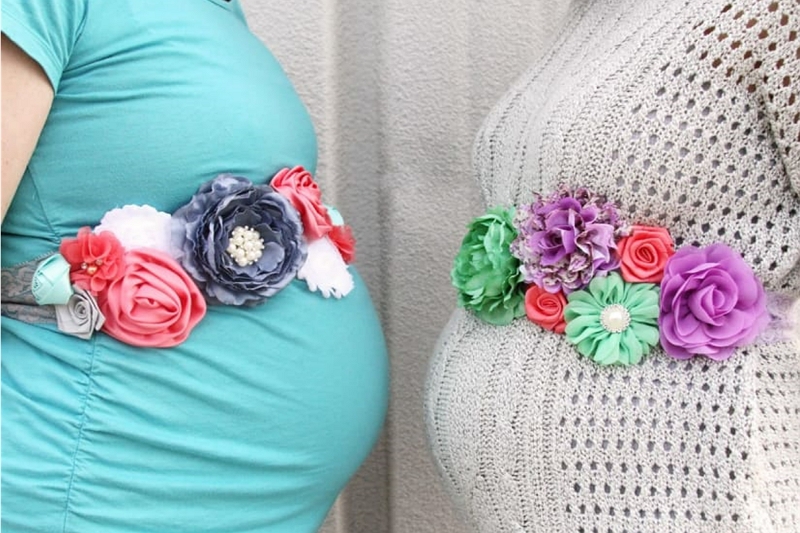In this blog, you will learn How to Make a Maternity Sash in easy and simple steps.
Maternity sashes are a great way to show off how much you have grown with your pregnancy. This is a how-to guide that will help you create the perfect maternity sash for yourself or as a gift for someone else.

Simple Steps on How to Make a Maternity Sash
The first step in this how-to is to measure around your waist and then add about an inch onto it so that there is enough fabric to tie into a bow at either end of the ribbon.
The second step, which can be done before or after measuring, is finding out what colour ribbon you want. You can use any type of ribbon from thin satin ribbons to wide grosgrain ones! Once you have decided how long of a ribbon you want, cut it with scissors.
The third step is to fold the ends over so that there are no sharp edges on your sash and then sew them closed.
Step four is tying the bow at each end of the sash. To do this, first, tie one piece around itself in a knot or double-knot before looping both pieces together into another larger knot.
Don’t worry about how big or small this looks at first – just tighten it down as much as possible afterwards by pulling on all three strings until they are taut against the backside of your body where nobody will see them! Finally, trim off any extra ribbon sticking out from underneath either side after tightening it all down.
Step five is how to wear your maternity sash! This step can be tricky because you’ll want it tied up just tight enough so that the bow stays in place but not too tight where you feel like you’re cutting off circulation or breathing. You’ll probably find that wrapping it around your body twice and then pulling the loops through themselves works best for most people, although others might prefer only using one loop instead of two.
Just experiment with how many times you tie yourself into this thing until everything feels comfortable; there are no real rules here when it comes to how exactly this should go.
When should I start wearing maternity bras?
You should start wearing maternity bras once you notice your regular bras no longer fit and are leaving marks on the skin. If this is not an issue then it doesn’t necessarily mean that maternity bras will also become uncomfortable, however, there is a chance they may be more comfortable than regular ones!
What is postpartum hair loss?
Postpartum hair loss can be incredibly distressing and it’s important not to mistake this as a sign that you are going bald! This kind of hair loss usually occurs around three months after giving birth and should normalize within six to twelve months from childbirth. It can often become particularly noticeable during pregnancy due to hormonal changes but will settle down once breastfeeding has been stopped completely.
Loss in patches or clumps may suggest an underlying issue such as iron deficiency which could have been present before pregnancy. Pregnancy itself can also cause hair loss, but this will settle down once you have given birth and your hormones return to normal levels again.
If the hair does not grow back within six months of childbirth then it may be worth seeing a doctor just in case there is something more severe going on underneath the surface. It’s always advisable to seek medical advice if postpartum hair loss persists as it could indicate an underlying thyroid condition or even alopecia areata, which causes patchy bald spots that come and go with no real rhyme or reason!
This kind of autoimmune disease usually affects adults who tend to lose their eyebrows first before gradually losing all their scalp hair too – sometimes very suddenly without any warning signs at all.
Can I extend my maternity leave?
No, you cannot extend your maternity leave. It ends when it is supposed to end.
How much time off work after childbirth should I take?
You are entitled to 52 weeks of Statutory Maternity Leave which includes 26 weeks of ordinary maternity leave and one additional week for each complete year that you have worked with your employer before giving birth (up to a maximum of six months). After this period, many employers offer their employees flexible working options so they can balance home life with their career goals.
How do I become a labour and delivery nurse?
To become a labour and delivery nurse, you must have completed your education. You may be able to do on-the-job training while working as an agency nurse if this is required by the organization or facility where you wish to work.
How do you survive unpaid maternity leave?
There are many ways to survive unpaid maternity leave including part-time work, working from home and freelancing.
How do you become a labour and delivery nurse?
To become a labour and delivery nurse, you must have completed your education. You may be able to do on-the-job training while working as an agency nurse if this is required by the organization or facility where you wish to work. The average salary for a maternity nurse is $33.07 per hour or $67,000 annually. There are many ways to survive unpaid maternity leave including part-time work, working from home and freelancing.
